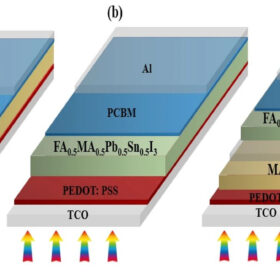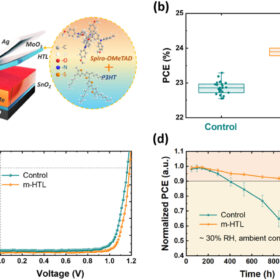Perovskite solar cell based on Mortise-Tenon tech achieves 24.55% efficiency
Chinese researchers have used Mortise-Tenon technology to connect the perovskite absorber with the hole transport layer in a perovskite solar cell. They say that this reduces non-radiative recombination, while improving the cell’s open-circuit voltage and fill factor.
Futurasun acquires solar perovskite startup
Futurasun, an Italian module manufacturer, has acquired Rome-based Solertix. It now aims to bring its perovskite-based solar cell technology closer to commercial production.
Novel design for inverted all-perovskite bilayer solar cells with 24.83% efficiency
An international research team has crafted an innovative solar cell design. By employing a top absorber consisting of methylammonium lead iodide (MAPbI3), a lead-halide perovskite, and a bottom absorber composed of FA0.5MA0.5Pb0.5Sn0.5I3, a perovskite material, the cell maximizes light absorption across a broad spectrum.
Weekend Read: Pushing perovskite PV limits
The perovskite solar race is heating up, with a cue of manufacturers forming to test products at the US Department of Energy’s (DoE) PV commercialization facilities, and academics on both sides of The Pond announcing new advances in recent months.
US startup develops flexible inverted perovskite solar cell with 16.1% efficiency
Scientists from the US National Renewable Energy Laboratory (NREL) and the University of Louisville have developed a revolutionary solar cell using yttrium-doped tin oxide nanoparticles. The innovation improves charge extraction and overall cell performance.
New perovskite solar cell design promises 31.09% efficiency
Chinese researchers have developed a solar cell using CsSnI3 perovskite, known for its unique phase transitions and near-IR emissions. By simulating the device with various electron transport layers (ETLs) and hole transport layers (HTLs), they determined that the optimal cell could be created using a titanium oxide (TiO2) ETL and a nickel(II) oxide (NiOx) HTL.
Carbon electrode perovskite solar cell with 20.8% efficiency
Researchers in China have built one of the most efficient carbon electrode perovskite solar cells ever reported to date. The device uses an organic/inorganic planar hole transport layer structure that purportedly has superior electrical contact.
Perovskite solar cell achieves 24.3% efficiency, high stability via binary mixed hole transport layer
Researchers in China have built a hole transport layer with a mixed binary configuration integrating the polymer Regioregular poly(3-hexylthiophene) (P3HT) and Spiro-OMeTAD. They used it to build a perovskite solar cell that was able to retain 90% of its initial efficiency after 1,200 hours of storage in dark ambient environment.
3D/2D perovskite solar cell treated with substituted PEAI hits 23.08% efficiency
An international research team has fabricated a quasi-2D perovskite solar cell with a special kind of phenethylammonium iodide (PEAI) salt to enhance hole extraction. The result is a 23.08%-efficient device that is also able to retain 95% of its initial efficiency after 900 hours.
Translucent tandem perovskite-perovskite solar cells for BIPV
An international research group has made translucent perovskite solar cells to maintain decent levels of average visible transmittance (AVT) while offering higher efficiency. They tested different module and cell configurations and produced a two-terminal, perovskite-perovskite tandem device with an efficiency of 17.7% at 12% AVT.










